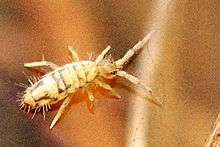Entomobrya nivalis
Entomobrya nivalis, the cosmopolitan springtail, is a species of slender springtails in the family Entomobryidae.[1][2]
| Entomobrya nivalis | |
|---|---|
 | |
| Scientific classification | |
| Kingdom: | Animalia |
| Phylum: | Arthropoda |
| Class: | Entognatha (?) |
| Family: | Entomobryidae |
| Genus: | Entomobrya |
| Species: | E. nivalis |
| Binomial name | |
| Entomobrya nivalis | |
Description
The cosmopolitan springtail measures about 2 mm in length. Its color consists of a yellow or white background with dark pigment forming transversal bands along the third segment of the thorax and the segments 2 to 6 of the abdomen. The fourth segment of the abdomen has a U- or 11-shaped pattern that easily distinguishes this species from others in the genus Entomobrya.[3]
Ecology
The cosmopolitan springtail is found in temperate and polar regions of North America and Europe.[3][4] Juveniles usually live in the leaf litter of forests and migrate upward after becoming adults, living among lichens growing on trees. During winter, they shelter under loose portions of bark.[5]
The hemolymph of the cosmopolitan springtail is rich in antifreeze compounds, allowing it to withstand the very low temperatures of winter.[5]
References
- "Entomobrya nivalis Report". Integrated Taxonomic Information System. Retrieved 2018-05-02.
- "Entomobrya nivalis species details". Catalogue of Life. Retrieved 2018-05-02.
- Katz, A.D.; Giordano, R.; Soto-Adames, F. (2015). "Taxonomic review and phylogenetic analysis of fifteen North American Entomobrya (Collembola, Entomobryidae), including four new species". ZooKeys. 525. doi:10.3897/zookeys.525.6020.
- "Entomobrya nivalis". GBIF. Retrieved 2018-05-02.
- Meier, P.; Zettel, J . (1997). "Cold hardiness in Entomobrya nivalis (Collembola, Entomobryidae): annual cycle of polyols and antifreeze proteins, and antifreeze triggering by temperature and photoperiod". Journal of Comparative Physiology B. 167 (4): 297–304. doi:10.1007/s003600050077. ISSN 0174-1578.
Further reading
- Katz, A. D.; Giordano, R.; Soto-Adames, F. (2015). "Taxonomic review and phylogenetic analysis of fifteen North American Entomobrya (Collembola, Entomobryidae), including four new species". ZooKeys (525): 1–75. doi:10.3897/zookeys.525.6020. PMC 4607850. PMID 26487816.